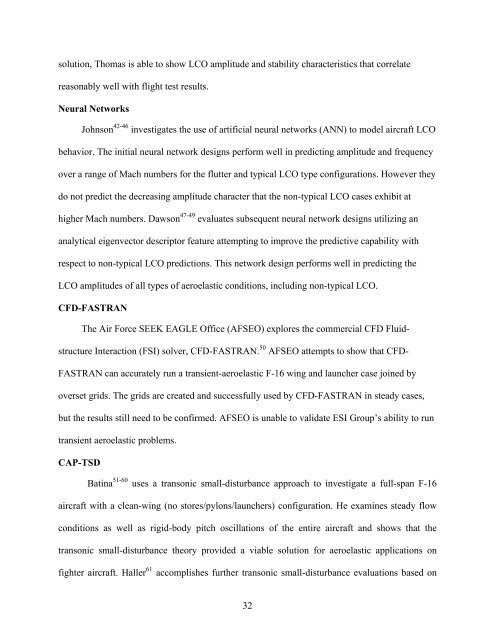university of florida thesis or dissertation formatting template
university of florida thesis or dissertation formatting template
university of florida thesis or dissertation formatting template
Create successful ePaper yourself
Turn your PDF publications into a flip-book with our unique Google optimized e-Paper software.
solution, Thomas is able to show LCO amplitude and stability characteristics that c<strong>or</strong>relate<br />
reasonably well with flight test results.<br />
Neural Netw<strong>or</strong>ks<br />
Johnson 42-46 investigates the use <strong>of</strong> artificial neural netw<strong>or</strong>ks (ANN) to model aircraft LCO<br />
behavi<strong>or</strong>. The initial neural netw<strong>or</strong>k designs perf<strong>or</strong>m well in predicting amplitude and frequency<br />
over a range <strong>of</strong> Mach numbers f<strong>or</strong> the flutter and typical LCO type configurations. However they<br />
do not predict the decreasing amplitude character that the non-typical LCO cases exhibit at<br />
higher Mach numbers. Dawson 47-49 evaluates subsequent neural netw<strong>or</strong>k designs utilizing an<br />
analytical eigenvect<strong>or</strong> descript<strong>or</strong> feature attempting to improve the predictive capability with<br />
respect to non-typical LCO predictions. This netw<strong>or</strong>k design perf<strong>or</strong>ms well in predicting the<br />
LCO amplitudes <strong>of</strong> all types <strong>of</strong> aeroelastic conditions, including non-typical LCO.<br />
CFD-FASTRAN<br />
The Air F<strong>or</strong>ce SEEK EAGLE Office (AFSEO) expl<strong>or</strong>es the commercial CFD Fluid-<br />
structure Interaction (FSI) solver, CFD-FASTRAN. 50 AFSEO attempts to show that CFD-<br />
FASTRAN can accurately run a transient-aeroelastic F-16 wing and launcher case joined by<br />
overset grids. The grids are created and successfully used by CFD-FASTRAN in steady cases,<br />
but the results still need to be confirmed. AFSEO is unable to validate ESI Group’s ability to run<br />
transient aeroelastic problems.<br />
CAP-TSD<br />
Batina 51-60 uses a transonic small-disturbance approach to investigate a full-span F-16<br />
aircraft with a clean-wing (no st<strong>or</strong>es/pylons/launchers) configuration. He examines steady flow<br />
conditions as well as rigid-body pitch oscillations <strong>of</strong> the entire aircraft and shows that the<br />
transonic small-disturbance the<strong>or</strong>y provided a viable solution f<strong>or</strong> aeroelastic applications on<br />
fighter aircraft. Haller 61 accomplishes further transonic small-disturbance evaluations based on<br />
32
















